Welcome to the Janison Academy help portal
Learning
The CLS supports a number of learning assets including courses, tests, discussion forums, and face to face events. A learner does not enrol in these directly, but instead enrols in a Catalogue Item that is linked to the learning asset.
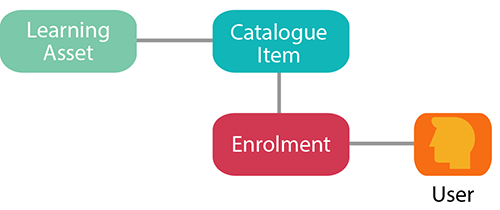
A catalogue item is the container for learning assets and has many settings and features. The features available within a catalogue item depend on the plugins enabled on your site. For example you will not see the competencies section if you do not have the competency plugin active. There are also settings available which provide options to change the way catalogue items display and function. See the document on catalogue item settings for further information.
If a catalogue item contains only one linked learning asset, it is referred to as a catalogue item. If the catalogue item contains more than one learning asset it becomes known as a Program.

The icon in the Type column of the catalogue manager represents the type of learning asset linked to the catalogue item. Hovering over the icon will generate a pop-up with the learning asset type, e.g. Janison Course.

The icon changes when more than one asset is added .
.

Catalogue management can be reached by browsing to Manage Learning > Manage Catalogue.

Browse to Manage Learning > Manage Catalogue

The Add Catalogue Item popup will be displayed.
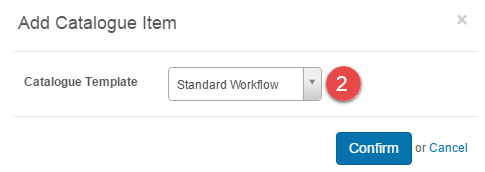
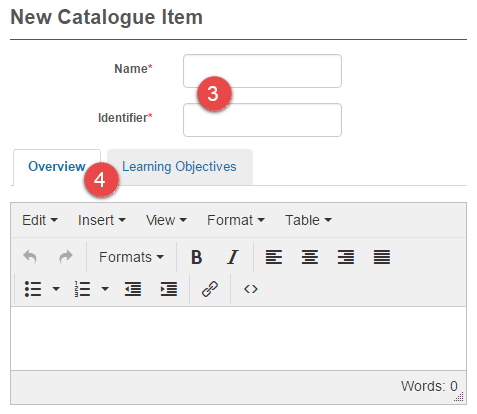
Basic settings is covered in detail below.
 icon.
icon.
Select Save Catalogue Item.

The settings in this section are optional. When populated, some setting information will appear the information page when the catalogue item is launched. Some information will appear on my learning transcript. Read more about my learning transcript.


Catalogue items can be added using a wizard. You can find out more about this feature in our document on add learning wizard.
Learning assets are added to catalogue items in this section. Functionality is available to be optionally set here.
 icon.
icon.
 icon to remove a component and the
icon to remove a component and the  icon to reorder the components.
icon to reorder the components.
Component Grouping provides a way to organise learning assets in a catalogue items into groups.
In the example below there are three groups of learning assets:
Learners expand these sections to view and launch the learning assets.
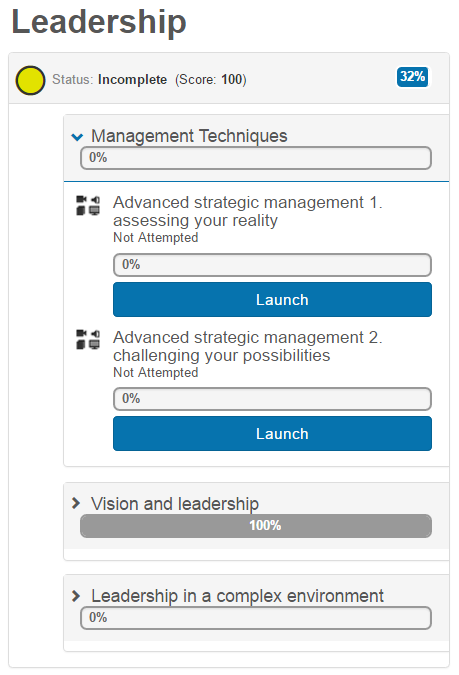
The option to group components is not available unless activated. Browse to Settings > Catalogue Item Settings.

Select Save Settings.

Open the catalogue item in edit mode.
 icon.
icon.
It will add a group to the components.

 icon.
icon.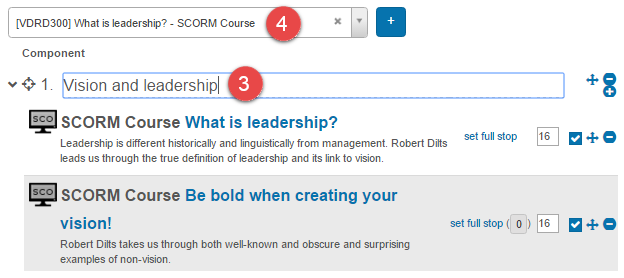
In this example, three groups have added, each containing two learning assets.

You can re-order the groups using the icon and remove groups using the
icon and remove groups using the icon.
icon.
Learners will view the catalogue item as below with access to launch the assets from the Launch buttons.

Components groups can be nested within other components groups. There are two methods:
 icon next to the group that you want to nest and drag it onto the name of the group where it should be nested.
icon next to the group that you want to nest and drag it onto the name of the group where it should be nested.
They will be presented to learners as nested items, as shown below.

This feature provides functionality to specify a number of learning assets within the group that need to be completed. In the example below there are three learning assets in the group but a learner only has to complete one to meet the completion requirements.

The ability to add Component Equivalency Groups will only become available in the catalogue item if the setting is enabled. Browse to Settings > Catalogue Item Settings.
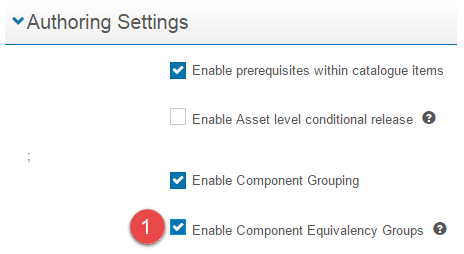

Open the catalogue item in edit mode.

An equivalency group will be displayed.



When a learner opens the catalogue item, a notification with the number of components they need to complete will be displayed.

Multiple equivalency groups can be added to a single catalogue item, alongside other components. In the below example two equivalency groups have been added.

Prerequisites can be set between the equivalency groups. See the document on prerequisites within programs for further information.
In the below example Leadership 101 has been set as a prerequisite for Leadership 102, therefore the Launch buttons for Leadership 102 will stay inactive until the required components in Leadership 101 have been completed. An inactive launch button will have a lighter background colour.

Equivalency groups can be added within Catalogue Component Groups. See the document on Catalogue Component Grouping for further information.
The opposite is not possible, Catalogue Component Groups cannot be added inside Equivalency Groups.

It will be presented to learners as below.

Inspecting a Catalogue Item gives you access to view information about it and allows you to edit some sections. The screen also offers the opportunity to edit more details about the Catalogue Item by selecting Edit Catalogue Item from the Actions drop-down menu, see Edit Catalogue Item.

To inspect a Catalogue Item select Manage Learning > Manage Catalogue and select the required Catalogue Item.
Data about enrolled Users is displayed:

Each piece of data is a link to the Enrolments section of the CLS where the appropriate selection of Enrolments in the Catalogue Item will be listed. If required these enrolments can be modified.
The Instalaunch link is a link that can be copied and sent to learners via email or other means. When the learner clicks the link they will be taken to the login screen of the site. Once they have logged in they will be directed to the Catalogue Item and enrolled automatically.

NOTE: There are two requirements to make the Instalaunch link available to learners:
The Catalogue Status controls enrolment access to the Catalogue Item.

Make Private removes the item from Browse Learning. Although it will not be possible for learners to find the Catalogue item. They can still be enrolled in it, for example manually by an administrator or via an enrolment rule.
Make Public adds the item to the catalogue. Learners will see the Catalogue Item in Browse Learning.
Archive will remove the Catalogue Item from Browse Learning as well as restrict any further enrolments.
The Learning Asset linked to this Catalogue Item is listed in this screen. The name of the asset is a link to the asset.

This section provides information on workflow approval, the ability to add tags and gives you access to custom pages.

This feature can be used to gather information about a catalogue item so that when an approver views the catalogue item they can use this as criterion for approval. For example, a catalogue item developer may be required to check a box to confirm that they have permission to use the content in their catalogue item.


This section is only displayed if a catalogue item template is used which has a custom attribute set selected in the custom attributes section.

You can find out more about this feature in our document on catalogue item templates.
The main purpose for tagging catalogue items is to categorise them and make them searchable, especially in browse learning.
Browse learning is a page available to learners where they can browse the learning assets available to them. By default the learning assets are listed on the page without any categorisation. See the documents on Browse Learning and Tags and Tag Types for further information on these topics.
Tags can be controlled in many ways in catalogue item templates. For example you can set tags that the catalogue item will be automatically tagged with, mandatory tags and tag restrictions. You can read more about this topic in our document on catalogue item templates.

Select the icon to edit and link new tags.
icon to edit and link new tags.

Below is an example of how the tags selected above can be used when the tag type is added as a top filter on the browse learning screen. See the document on Browse Learning for further information on how to set the filters up.

Tags can also be assigned to existing catalogue items in bulk. You can find out more about this feature in our document on Import Catalogue Item Tags.
Custom pages can be set here by using a custom attribute type of custom views. These pages can be used to gather information.
You can find out more about this feature in our document on custom views.
Points are numeric values used to set and achieve Continuing Professional Development (CPD) requirements. This is explained in detail in the document on Continuing Professional Development.

Competency can be defined as the ability of an individual to do their job properly. Competencies and competency sets can be linked to catalogue items so that they are achieved on completion of the catalogue item. See the document on competencies for further information.

To add or edit competencies you will need to edit the Catalogue Item.
Prerequisites between catalogue items prevent learners from accessing catalogue items until they have completed other specified catalogue items. They are managed using prerequisite groups. A learner must complete at least one Item from one or more groups before they can enrol in the catalogue item.
In the diagram below a learner must complete one catalogue item from group 1 and one item from group 2 before they can access Catalogue item F.

Prerequisite are set within a catalogue item in the prerequisites section.
Browse to Manage Learning > Manage Catalogue and open the required catalogue item.
 icon.
icon.

If a learner has not completed the relevant prerequisites for a catalogue item, they will not be permitted to enrol. When they attempt to self-enrol, they will encounter the below screen. The items in the groups are links to allow easy access to the prerequisite items.

Catalogue item prerequisites only apply when a learner self-enrols. When administrators enrol learners into a catalogue items directly, this bypasses the prerequisite requirements. The following methods also bypass the prerequisites requirements, as they directly enrol the user in the catalogue item:
Prerequisites within catalogue items prevent learners from accessing learning assets within a single catalogue item, until they have completed other specified learning assets.
In the diagram below, a learner must complete component 1 before they can access component 2.

A setting must be activated before this feature can be used.
Browse to Settings > Catalogue Item Settings.


Prerequisites are controlled using the set full stop and clear full stop links in the components section of the catalogue item.
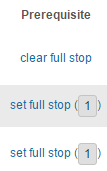
Browse to Manage Learning > Manage Catalogue and open the required catalogue item in edit mode.
 appears on the component below. This means that the component, in this case Break down the project, is now the prerequisite for the component below, in this case Assigning roles in the project. Break down the project must be completed before Assigning roles in the project can be accessed.
appears on the component below. This means that the component, in this case Break down the project, is now the prerequisite for the component below, in this case Assigning roles in the project. Break down the project must be completed before Assigning roles in the project can be accessed. to view the prerequisite. The prerequisite can be removed by unchecking the box .
to view the prerequisite. The prerequisite can be removed by unchecking the box .To remove a prerequisite select clear full stop.


Note that the order of a component in the list is important: you can only set a component as a prerequisite to another component if it comes before that component in the list. Thus, the first component has no number in brackets because it can’t have a prerequisite component.
When you subsequently edit a Program and view its previously created prerequisites, all the links will reset to set full stop however the list of prerequisites that you set for each component remains the same as before.
In this example, Break down the project is set as a prerequisite for Assigning roles in the project. The launch button for Break down the project is active but the launch button for Assigning roles in the project is inactive.
Active buttons are a dark shade and inactive buttons are a light shade.
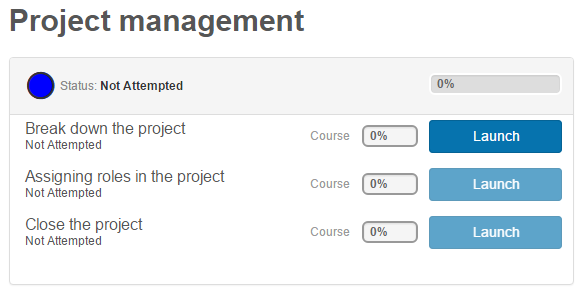
In the same catalogue item below, the learner has now completed Break down the project.
Assigning roles in the project is set as a prerequisite for Close the project. The launch button for Assigning roles in the project is now active while the launch button for Close the project will remain inactive until Assigning roles in the project is completed.
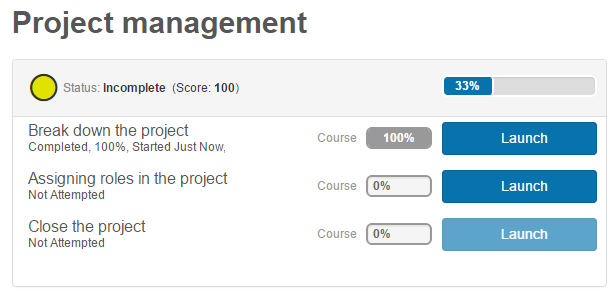
Large Thumbnail URL allows you to add an image to the Catalogue Item tile.

The Catalogue Item tile is displayed below does not have a thumbnail.

A thumbnail has been added to the Catalogue Item tile below.

The section will appear if a custom attribute is created and a Linked Object of type Catalogue Item is selected. See the document on Custom Attributes for further information. An example of a use of this is for an external course ID where the Janison Catalogue Item needs a second identifier to marry it to another system.

These section controls the way learners enrol in a catalogue item.

This will determine whether learners can automatically enrol or if they need to go through a workflow or payment gateway. See the documents on self-enrolment settings and payment settings – catalogue item configurations for details about the available options.

This drop-down can be used to select preconfigured questions which will be displayed to learners during the enrolment process. Their purpose is to collect information from users. See the document on custom attributes and self enrolment questions for details on how to create the questions.

The questions will be presented to the learner during enrolment.

These options can be set to restrict re-enrolments

Never allow re-enrolment – Users will never be able to self-enrol a second time for this item. Note that administrators are not bound by this rule, and they can re-enrol users at any time.
Allow re-enrolment at any time – Users will be allowed to self-enrol any time after completing an enrolment.
Allow re-enrolment after a specified period – Users will be allowed to self-enrol a specified period after completing the preceding enrolment. Under this setting, users must still complete any earlier enrolments prior to enrolling again.
To set a time enter a number and select a unit of time from the drop-down box:


If checked this setting will trigger an email notification to managers when learners self-enrol. The Message Template used for this notification is Enrolment-ManagerConfirmation.

You can set an expiry date if learners must re-do learning in order to keep their learning up to date.

Expiry dates can be reported on using the customisable reports feature. The learner will see the expiry date on the catalogue tile when they access their My Learning page.

They will also see the expiry date on My Learning Transcript.

Sometimes it can be important to restrict the amount of time that a learner has to access content after they complete it. It is therefore possible to restrict access to content after a specified time.

There are a number of ways that User enrolment in a Catalogue Item can take place. See the linked documents below for further details on each method.
See Enrolments for more general information about managing enrolments once they have been created.
Some sections of catalogue items can be edited from the actions dropdown and other sections inline.
 icon, it can be edited inline.
icon, it can be edited inline.
Selecting Edit Catalogue Item will direct you to a similar screen as you would encounter when you create a catalogue item.
Selecting the Edit in Wizard link will take you to step 2 of the add learning wizard. You can find out more about this feature in our document on add learning.
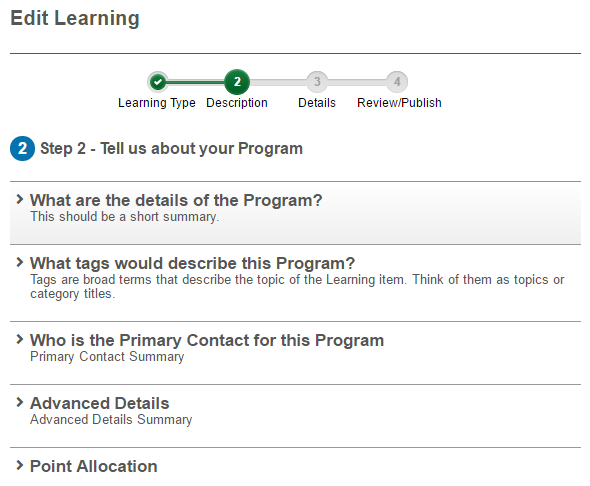
Programs are catalogue items that have more than one linked component, that is, more than one linked learning asset.
Programs can become quite complex structurally so the facility to copy them is available.
Browse to Manage Learning > Manage Catalogue and select a catalogue item you would like to copy.
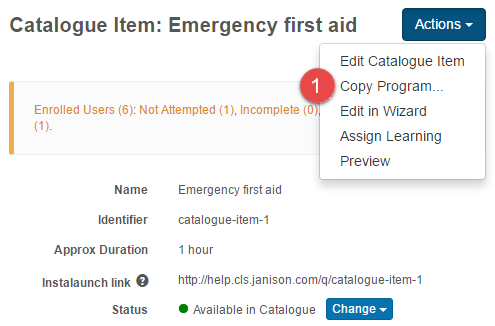
You will be directed to a New Catalogue Item screen with Copy appended to the original program name. You can optionally edit the details.


You can preview a program as a learner would see it.
Select Preview from the Actions dropdown.

You will be taken to a separate window with the program displayed. The program will be fully functional so can be used for testing purposes.
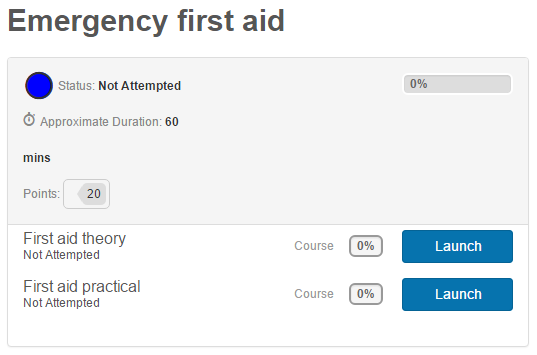
The catalogue manager provides access to manage catalogue items.
Browse to Manage Learning > Manage Catalogue.
Catalogue items are filtered into several tabs:

The statuses of catalogue items can be set in bulk or individually.

If a catalogue item is opened, the status can be changed using the dropdown.

Details of the status change can be viewed by hovering over the![]() icon.
icon.

The assign learning wizard is a setup assistant that offers authorised users a series of dialog boxes to complete the steps required to enrol users in one or more catalogue items.
To run the asign learning wizard:
Browse to Manage Learning > Manage Catalogue and select the required catalogue item.

This directs you to step 1 of the assign learning wizard. As you have been directed here from the catalogue item, the content has already been added and will appear in the Added Content section. You can find out more about this feature in our document on assign learning.

Tags can be added to individual catalogue items at a catalogue item level. You can find out more about this feature in our document on Metadata. In the situation where you need to add tags in bulk, you can import them from the spreadsheet.
Browse to Manage Learning > Manage Catalogue.

You will be directed to the Add Catalogue Items with Tags from spreadsheet screen.

You will be directed to a screen where feedback will be displayed.
If issues exist, an error message will be displayed.

If no issues exist, the following feedback will be displayed.

An email will then be sent with further feedback about the import.

This feature enables an administrator to designate specific catalogue items for consequent enrolment changes. These either create or expire enrolments, once a learner completes an enrolment in the catalogue item.
To activate this feature, a setting in the catalogue item template needs to be turned on. You can find general information on catalogue item templates here.
1. Open the template and expand the Optional Inclusions section.
2. Select Consequent Enrolment Changes.
3. Select Update.

This will activate a section, Consequent Enrolment Changes, in catalogue items using that template.
Two options are available to control enrolment changes.

1300 857 687 (Australia)
+61 2 6652 9850 (International)
ACN 091 302 975
ABN 35 081 897 494
© 2024 Janison
Janison acknowledges the traditional owners of the land on which we work and meet. We acknowledge the continuous care of the land, animals and waterways. We pay our respects to Elders past, present and emerging.